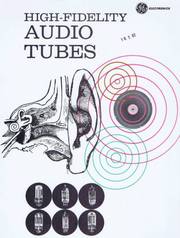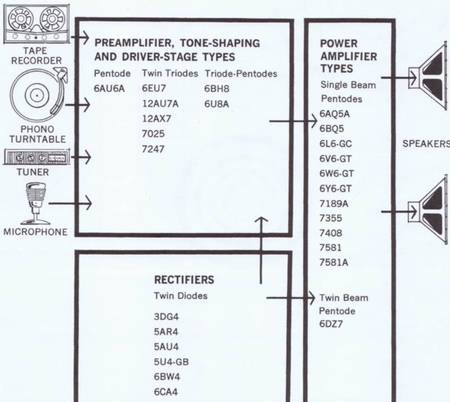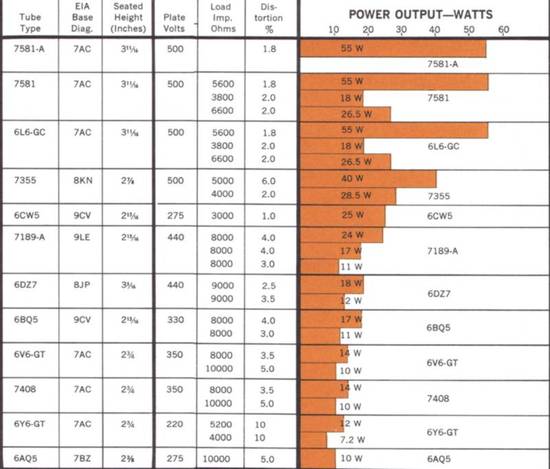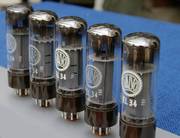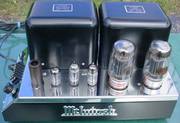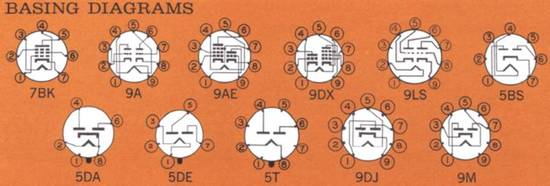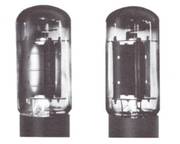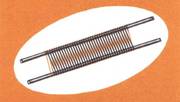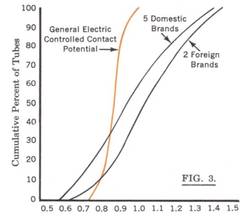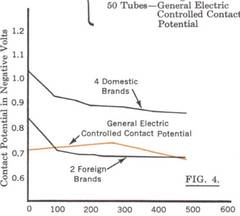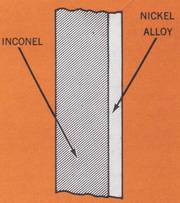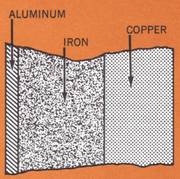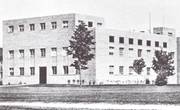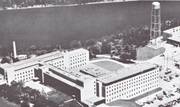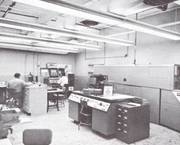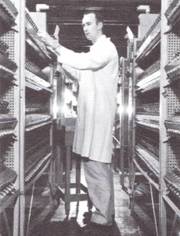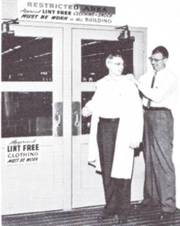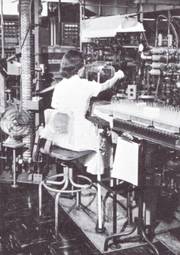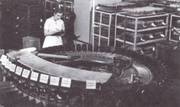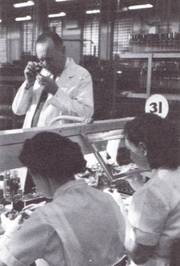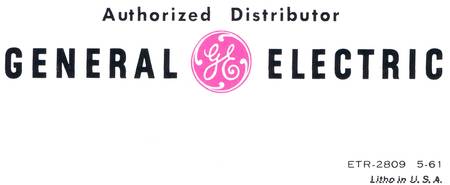1961 - "GE"-High-Fidelity Audio Tubes (vom Mai 1961)
Now you can design hi-fi equipment to meet your need with General Electric's complete line of audio tubes .........
- Anmerkung :
Es war die Zeit des Umbruchs, als die ersten brauch- baren Silizium Transistoren die unzureichenden Germanium Typen ablösten. - Und auf einmal funktionierten (zumindest) die ersten Labor-Verstärker.
Den Röhrenherstellern stand ab jetzt das Wasser bis zum Hals, denn es war jetzt sehr leicht, visionär vorauszusehen oder einfach nur zu erahnen, daß die Röhre kurzfristig (in ganz wenigen Jahren) aus dem gesamten (und damals sehr großen) Audio-Markt verdrängt würde.
Von dem kommenden Farbfernsehmarkt (wir haben in 2018 einen der allerersten Farbfernseher mit 27 Röhren - einen Philips K6 von 1966 erhalten) redete 1961 bislang noch keiner. Bei den Kofferradios war der Umbruch in 1961 schon in vollem Gange. Alle Hersteller hatten Probleme (Leidensdruck) mit der viel zu kurzen Betriebszeit der Batterien. Siehe das Beispiel der BRAUN AG von 1958.
- Anmerkung 2 :
Das europäische Gegenstück zu der amerikanischen 6CA7 ist die Leistungsröhre EL34 von Philips.
.
FOR HI-FI ONLY ...
Recognizing the trend towards increased performance in audio equipment, and anticipating the growing need for tubes specifically designed for high-fidelity applications, the G-E Receiving Tube Department has expanded its line of hi-fi audio tubes to the point where it is now possible to design equipment to meet a need, not a tube-type. No longer must the equipment designer be limited to tube-types not specifically designed for hi-fi circuits.
The G-E Receiving Tube Department has approximately 50 technical personnel engaged in hi-fi audio tube work to insure that G.E. will be the first to bring you the newest electron tube developments when they are needed. The personnel of this section are at your disposal for technical help in selecting tubes, in circuit design, and even designing new tube-types for a particular application.
This booklet was prepared by the G-E Technical Information and Product Service (TIPS) group to acquaint you with the extent and features of the G-E hi-fi audio tube line and to familiarize you with all the benefits and services available from the G-E sales and engineering staffs.
TABLE OF CONTENTS (in diesem Werbe-Prospekt)
.
- EXTENT AND FEATURES OF G-E AUDIO TUBE LINE . 1
- Classes of Tubes and Tube-Types . 1
- Specifications:
- Power Amplifier . 2-3
- Tubes Preamplifier Tubes . 4
- Rectifier Tubes . 4
- CREATIVE ENGINEERING . 8
- "SNOW WHITE" MANUFACTURING . 10
- TECHNICAL INFORMATION AND PRODUCT SERVICE . 12
.
EXTENT AND FEATURES OF GE AUDIO TUBE LINE
As recently as 1950, less than a dozen electron tube-types were suitable for true high-fidelity audio applications, and none, outside of custom-made foreign brands, were designed specifically for hi-fi service alone.
Presently, (gemeint ist 1961 !!) G.E. offers 26 different tube-types specifically designed for high-fidelity audio service. Also, due to the dynamic character of the hi-fi industry, more types are currently under development in anticipation of future market demands.
Tubes are divided into three classifications, with recommended types listed below each heading. Detailed design data on each type are given in the specification charts on the following pages.
.
CLASSES OF TUBES AND TUBE-TYPES
.
GE AUDIO POWER-AMPLIFIER TUBES
Das ist eine vom Röhrenhersteller G.E. zusammengestellte Tabelle mit den "möglichen" verstärker-Leistungen der einzelnen Röhren.
.
.
Anmerkung zur Lebendsdauer von Röhren:
Diese sogenannten "Power-Ratings" sind die vom Hersteller spezifizierten (idealerweise) maximalen Leistungen - aber "im Neu- zustand" !!!! - Das zu erkennen und zu beachten ist ganz ganz wichtig, denn die Röhren "an sich" schlaffen nach wenigen 100 Betriebsstunden gewaltig ab.
In den größeren Kinos der 1960er Jahre konnte man das an den sehr bekannten EL34 Typen (25 oder 30 Watt Sinus) sehen. Die mußten relativ häufig erneuert werden - weil der Kinoton ja ununterbrochen volle Pulle gespielt wurde - oder es ging einfach nicht mehr richtig laut im Kino-Saal oder es verzerrte viel früher.
.
Es steht hier zwar nicht explizit geschrieben, doch die oben angegebenen Leistungsangaben beziehen sich immer auf eine Röhre, wobei bei einer simplen Gegentakt-Endstufe (für die ich mindestens ein Paar solcher Röhren benötige) dann die angegebenen Werte die absolute Leistungs-Grenze des überhaupt Machbaren war.
Im legendären McIntosh MC 275 Röhrenverstärker waren damals je Kanal 2 Röhren des Typs KT88 eingesetzt mit verlässlich spezifizierten 70 Watt Sinus pro Kanal (an allen 3 Impedanzen - mit Ausgangsübertrager) von 20 bis 20.000 Hz und 0,1% Klirrfaktor und das war damals eine unglaublich irre Menge High-End- Power.
.
FOOTNOTES :
.
- ++ The maximum screen (No. 2) grid voltage rating is 500 volts in push-pull circuits where the screen of each tube is connected to a tap on the plate winding of the output transformer.
- § The screen (Grid No. 2) dissipation rating may reach double the continuous duty rating shown during periods of maximum input of speech and music signals, under worst probable operating conditions as specified for the Design-Maximum rating system.
- + Value of cathode resistor in ohms.
- * Screen (No. 2) grid operating voltage for pentode types or sections.
- . Design-maximum ratings are limiting values of operating and environmental conditions applicable to a bogey tube of a specified type as defined by its published data and should not be exceeded under the worst probable conditions. The tube manufacturer chooses these values to provide acceptable serviceability of the tube, taking into account the effects of changes in operating conditions due to variations in characteristics of the tube under consideration.
.
The equipment manufacturer should design so that initially and throughout life no design-maximum value for the intended service is exceeded with a bogey tube under the worst probable operating conditions with respect to supply voltage variation, equipment component variation, variation in characteristics of all other tubes in the equipment, equipment control adjustment, load variation, signal variation, and environmental conditions.
.
BASING DIAGRAMS
LEADERSHIP IN DESIGN
Although General Electrie's line of hi-fi tubes incorporates hundreds of
design innovations that contribute to leadership in performance, the specific features depicted on these pages contribute highly to G.E.'s hi-fi product excellence.
Design Features-Power Amplifier Tubes
Five-Ply Anodes. New five-ply bonded anodes (Fig. 1) give better heat conduction and radiation than conventional single-layer anodes.
The bonded plate employs copper to conduct heat rapidly and to reflect heat where needed, aluminum to radiate heat, and iron to provide strength. Effectiveness of the new anode is demonstrated by the photographs in Fig. 2.
Text zu Bild 1: (FIG. 1) Cross section of General Electrie's new five-ply bonded anode found in high-fidelitv Dower amnlifier tubes.
Text zu Bild 1: (FIG. 2) Unretouched photo showing a conventional 6L6-GB (left) and G.E.'s new 6L6-GC with five-ply bonded anode, each operating at a plate dissipation of 80 watts. The 6L6-GB has bright orange "hot spots" on the plate, while the 6L6-GC plate shows only a uniform dull red, due to the superior heat-dissipating characteristics of the new anode.
.
Gold-plated Control Grids
In order to eliminate grid-emission problems due to overheating conventional-type grid wires, many high-fidelity power amplifier tubes have gold- or silver-plated control grids to permit higher power output.
Contoured Grids
The control grid, in most types in G.E.'s audio tube line, is specially contoured to provide nearly uniform spacing between it and the cathode, resulting in closer control of plate and screen-grid currents. Power sensitivity is also improved, so that power input (plate and screen dissipation) is reduced for the same power output, as compared to conventional control-grid contour.
Design Features-Preamplifier Tubes
Controlled Contact Potential. One of the difficulties hi-fi circuit designers encounter is the lack of uniformity in contact potential between voltage-amplifier tubes of the same type and production run. (Contact potential is defined by G.E. as the negative bias required between the grid and cathode to limit the grid current to 0.1 microampere.)
The designer can compensate for any fixed value of contact potential, but when the variations can range from -0.5V to -1.3V in any one type, compensation is impossible.
A new cathode alloy, developed by General Electric Company for use in their hi-fi preamplifier tubes, holds the initial variation between tubes to much narrower limits as compared to present domestic and foreign types, and maintains contact potential at a low and stable level throughout tube life. Test results are illustrated in Figs. 3 and 4.
.
Beispiel : TUBE-TYPE 12AX7
Messungen an 250 Exemplaren, um eine fundierte Aussage des Meßergebnisses machen zu können.
SAMPLE SIZE:
.
- 250 Tubes - Domestic Brands
- 100 Tubes - Foreign Brands
- 50 Tubes - General Electric
Controlled Contact Potential
.
Slotted Mica Spacers
Additional anti-leakage slots in mica spacers, used in preamplifier tubes, lengthen leakage paths between the plate and other tube elements to hold leakage to a minimum.
Design Features - Rectifier Tubes
Two-Ply Cathodes
In the new G-E power rectifiers, a nickel cathode-alloy clad on inconel provides higher resistivity and approximately four times the hot strength of nickel alloys used in conventional rectifiers.
This "sandwich-type" construction greatly reduces problems of cathode bowing and microphonics in tubes with hot cathodes.
It also enables the design of extremely long cylindrical cathodes that have high mechanical ruggedness.
.
Three-Ply Anodes
Use of copper-base aluminum-clad iron for the anode material results in uniform anode temperature and reduced cathode input requirements.
Heat is reflected, from the shiny copper surface, back to the cathode so that cathode input power is approximately 1.0 watt per square centimeter as compared to 2.0 to 3.0 watts per "sq. cm." for other rectifier designs.
- Anmerkung : Hier sehe ich zum ersten Mal, daß Amerikaner US-Produkte mit "quadrat-centimetern" spezifizieren anstelle mit "square-inches". Das war in den USA zu der Zeit um 1961 (immer noch) absolut gelinde ausgedrückt "unüblich". Der Grund erschließt sich bislang nicht. Vielleicht war da ein Deutscher mit im Labor. Erst in 2010 bekam ich Informationen darüber, wieviele deutsche Dipl. Ingenieure in USA bei HP und Tektronics und anderen Messgerätefirmen arbeiteten. Dipl.-Ing. Siegfried Linkwitz mit seinen sehr bekannten Linkwitz Filtern und den Linkwitz Boxen war auch ein ausgewanderter Deutscher.
.
CREATIVE ENGINEERING
. . . the integration of research, development, design and application, with but a single objective: the continuous improvement of our products and our ability. Constant research is conducted for new materials, new processes, and new concepts that will improve tubes and advance the state of the art. The multitude of products from our laboratories is testimony to this aim.
Of the 250 people in the Receiving Tube Department's Engineering Section at Owens-boro, Kentucky, approximately 50 are engaged specifically in audio tube work for high-fidelity applications. The Engineering Section performs product design, application, statistical, and advanced development engineering; product evaluation and reliability analyses; and operates the department's Chemical and Physics Laboratory.
This laboratory utilizes the most modern research tools to analyze materials and evaluate processing techniques used in tube manufacture. In addition to their own engineering and research groups, the Receiving Tube Department has at its disposal the resources of the main G-E Research and Electronics Laboratories employing over 1400 people. Entirely new concepts of tube design presently under development will open up new markets, provide better performance and allow improved styling, all at lower over-all cost to the equipment manufacturer.
.
APPLICATION ENGINEERING
Should the existing line of GE- hi-fi audio tubes fail to answer the customer's specific need, and if economics permit, the personnel of the Advanced Application Engineering Laboratory translate a customer's desire into a design objective. It is then given to the Design Engineering Group for conversion into an actual tube design.
Sample tubes are constructed and returned to the Advanced Application Section for evaluation against customer requirements and, if suitable, sent to the customer for evaluation in his equipment.
After the design is accepted, the Test Engineering Group devises any new test techniques that may be required to assure quality will be maintained throughout production. The final step before releasing the new design to manufacturing is to write complete electrical and mechanical specifications.
.
FIELD ENGINEERING
Highly qualified audio field-engineers render on-the-spot application engineering service to G-E customers. Their assistance in selecting the right tube to fill a particular need, and in the design of associated circuitry, saves the equipment manufacturer time and engineering expense.
Feedback of information by field personnel, concerning the customers' new-product needs, stimulates important audio tube development activities. You may obtain the services of a G-E field engineer by contacting your nearest Technical Information and Product Service (TIPS) Office (listed on back cover).
.
SNOW WHITE" MANUFACTURING
A number of years ago the airlines and military services asked the electronics industry for tubes that would operate unfailingly for extended periods under adverse conditions.
The General Electric Company responded with the now famous GE Five-Star high-reliability tubes for critical applications. The same manufacturing techniques and know-how are now being applied to the manufacture of precision high-fidelity audio tubes.
.
"OPERATION SNOW WHITE"
A portion of the quality-assurance program was "Operation Snow White" ... G.E.'s industry-famed program to reduce, as far as possible, the presence of foreign particles in the areas devoted to assembly, inspection and testing of high-fidelity audio tubes.
This program, in turn, effects corresponding reductions in the number of tube shorts and increases over-all tube reliability.
Lint, dust and dirt are prevented from contaminating these areas by use of:
- * Lint-free white uniforms worn by all production employees
- * Air-conditioning systems which maintain constant temperature and humidity
- * Filter-cleaned air, pressure-forced into plants to eliminate dust particles from entering underneath doors or through other small openings
- * Constant cleaning by a built-in vacuum network to eliminate dirt in the work area
In certain areas, operators work with their hands under glass hoods and wear rubber finger cots to prevent contamination. Trays of component parts are always housed in protective containers during manufacture.
The G.E. Receiving Tube Department's modern, efficient manufacturing facilities, embracing more than 1,000,000 square feet of area, are completely "Snow White."
Plants are located in Owensboro, Kentucky; Tell City, Indiana; and Anniston, Alabama. No other manufacturer, either domestic or foreign, has undertaken such specific measures to provide the degree of factory cleanliness and controlled environment found in the G.E. "Snow White" operation.
.
INSPECTION AND TESTING
Raw-Material Inspections.
Nearly 250 raw-material inspections guard G.E. "hi-fi tube quality". From the beginning, raw materials are specially selected to meet specific design requirements. Each incoming shipment is carefully inspected and tested to maintain constant quality and raw-material uniformity.
G.E.'s manufacturing philosophy of quality control "from the beginning'' is maintained throughout the production cycle of each G-E hi-fi tube. It is your assurance of product leadership.
In-Process Inspections.
High quality-control standards are maintained by hundreds of in-process inspection stations. Each manufacturing step includes careful inspection of component parts.
Close supervision of assembly workmanship prevents deviation from predetermined specifications. Quality control begins with inspection of each individual hi-fi tube part and continues through the complete assembly operation.
Performance Testing.
All G.E. "hi-fi receiving tubes" undergo rigorous characteristics tests which meet and exceed customer requirements. In addition, a representative sampling of each production lot is given a series of further acceptance and quality tests.
If the sample fails to measure up to G.E.'s high standards of quality, the entire production lot is rejected.
Applied Automation.
A constantly expanding program of mechanization and automation has been in operation in G.E.'s receiving tube factories for many years.
The scope of this program includes all phases of tube parts manfacturing, processing, assembly and exhaust operations, tube aging, factory and quality-control testing, and even placing finished tubes into cartons.
.
TECHNICAL INFORMATION AND PRODUCT SERVICE
The Technical Information and Product Service (TIPS) group was formed at the G.E. Receiving Tube Department's headquarters in Owensboro, Kentucky, to coordinate the preparation and dissemination of product literature, mailing lists, and assignments of technical field personnel.
Each of the department's eleven field sales offices (see back cover) is also a branch office of the TIPS group. These offices are manned by a staff of more than 50 competent receiving tube application specialists.
Should a particular design or application problem arise, and you need the help of these specialists, please remember that their time and services are at your disposal. A phone call to one of these local offices will illustrate, firsthand, the advantages of General Electric's service.
All field offices and headquarters maintain an inventory of current G-E receiving tube technical specifications, application bulletins and other publications which aid the equipment designer. This up-to-date information is yours for the asking.
.
FAST WAREHOUSE DELIVERY
The close proximity of General Electric's tube warehouses to the major high-fidelity markets provides manufacturers with substantial inventories of hi-fi tube-types available on a rush basis. This eliminates the risk of costly production shutdowns and missing the yearly hi-fi market cycles, due to the uncertainties of overseas transportation from foreign manufacturers.
Equipment manufacturers have the choice of same-day shipment on rush requirements; or, scheduled deliveries to suit their factory production needs.
.
CONCLUSION (von 1961 !!)
The General Electric Receiving Tube Department is playing an increasingly important role in supplying tubes for high-fidelity equipment, where innovation and continuing progress are the lifeblood of success.
.
Our figures show that GE. offers the widest selection of hi-fi tubes available today (1961). Specifications can prove superior performance ... but only firsthand experience can demonstrate that all-important bonus you receive when you use GE-tubes with GE-Service.
GE.'s hi-fi tubes for low-level stages offer multi-function design at the lowest cost per function, plus inherent stability over wide temperature variations. Semiconductor amplifying devices, on the other hand, are available only in single-function units requiring extra components to stabilize and temperature-compensate each stage.
They require expensive low-voltage, high-current, difficult-to-filter DC power supplies and increase the selling price of your equipment 75 to 100 percent above comparable tube-type equipment.
For example, in a typical 40-watt dual-channel stereo amplifier, 9 GE multi-function hi-fi tubes can deliver 14-tube performance. A comparable semiconductor-type amplifier will have 18 amplifying devices - and sell for a 75 percent higher price!
- Anmerkung : Das war 1961 noch so. Wenige Jahre später (Beispiel der Grundig SV50 vom August 1963) drehte sich das Verhältnis ganz gravierend zu Ungunsten der Röhrentechnologie rum. Die Röhre wurde viel zu teuer im Vergleich zu den dann extrem billigen Transistoren. Der erheblich höhere Stromverbrauch der Röhren-Verstärker spielte damals noch keine Rolle. Der Strom kam ja (noch) aus der Steckdose.
Offer General Electric the opportunity, today, to show you how GE high-fidelity tubes and service can benefit you directly and help improve your profit picture.
Remember ...............
.


